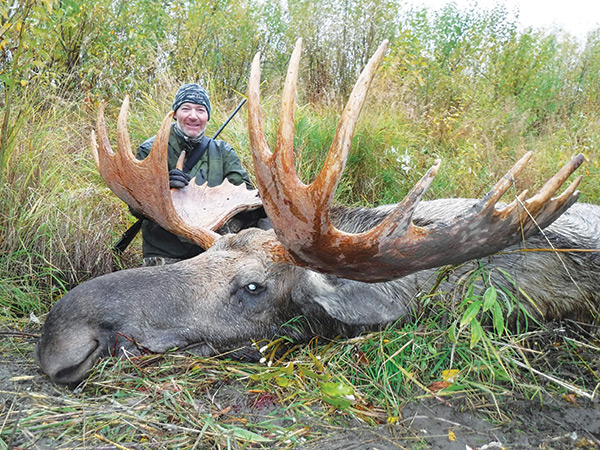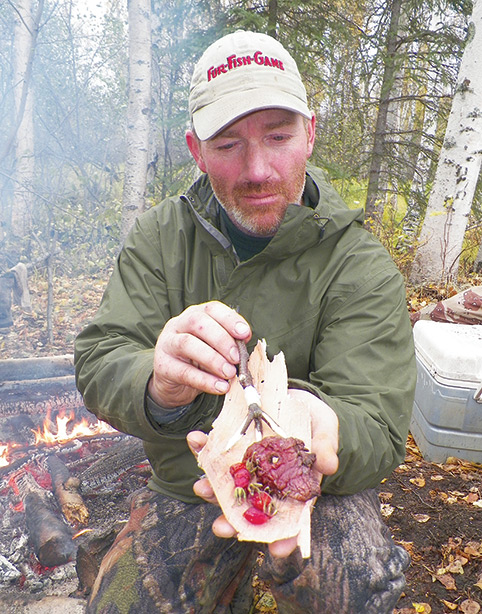 Wilderness Adventure: Yukon Moose
Wilderness Adventure: Yukon Moose
By Jack Spencer, Jr.

Yukon moose are the biggest game in North America. If you ever have an opportunity to hunt these animals, go and don’t look back. It’s hard to swallow the cost of flying to the edge of the world to hunt in the boreal forests of Alaska and Canada. But that’s where the big boys roam, and once you wrap your hands round a truly big set of antlers, you’ll understand why I happily drive old cars, pack a lunch for work each day, and take side jobs to pay to play this game.
The day the pilot dropped me and my hunting partner off last September was especially exciting. As we made the final descent I could tell the man was nervous, and when a bush pilot gets nervous, it freaks me out. The water was obviously down, the stretch of open river much shorter than the last time he had dropped me there. The loaded plane stopped just before the floats made contact with river rock.
After an hour pumping up the raft and then getting a good night’s rest, we floated downriver cow-calling every few minutes. I prefer to float rather than sit in one spot. I see new stuff every day and often enjoy world-class fishing along the way. The tough part when drifting is I cannot go back upstream to an area with better moose sign.
In between calling and casting for northern pike and sheefish, I raked a plastic jug along the oars to hopefully fire up any nearby bulls. Every once in awhile, I threw in some bull grunts. Mimicking moose sounds is actually pretty easy, and I do most of my calling with my own lungs and mouth. Even bad moose calling works later in the season. But it can be tiresome, and I knew I might have to keep up the pace for another 11 days unless we put two bulls in the boat before that.
The first day I called in a small bull and several cows under a sunny sky. It would be a long time before we again saw a moose—or the sun, for that matter.
Instead of the usual freezing nights and warm days of early September (called Moosetember by some locals), we were plagued with pouring rain and temperatures in the high 30s day and night. Such conditions make for miserable hunting and also suppress moose movement. Every day was a struggle to stay warm and dry, to keep calling and scraping. The energy required to find dry wood and feed a fire was better spent resting in the tent, to be ready to hunt before daylight and right after sunset.
Five days of pouring rain went by. A couple of bulls did answer my calls but none ventured out of the thick brush. One morning I was calling on a long gravel bar when a cow called back. It wasn’t a bull, but I was encouraged that a moose was at least showing some interest.
A pair of wolves trotted in and then back out without affording me a shot.
Throughout the day I would periodically paddle ashore and check for fresh moose sign. I finally found a track that appeared to be quite large. My entire boot fit in it, and I had to really stretch my leg to reach the next one.
No doubt that was a big bull.
A little farther downriver we located where a couple of big bulls had fought. The gravel bar was all tore up, mud slung everywhere. Trees as big around as baseball bats were snapped off. The whole area smelled like skunk, the foul odor of bull moose urine. It was by far the best sign we had seen, so we set up camp.
The rain was relentless, never really letting up between downpours. We had to erect a tarp and then set up the tent underneath to keep things dry.
But the wind subsided that evening, so I called upriver, downriver, and toward each bank. I found a big old log and whacked it with the backside of the ax, thuds echoing for miles, hopefully to be heard by a bull moose. The old sourdoughs used to fire a few shots after setting up moose camp, theory being that the crack of the rifle would travel farther and get distant bull moose moving their way.
We finally agreed to stay put for a few days because it can take a bull a day or longer to make it to a calling stand, especially in rainy weather.
The next morning the rain stopped right before daylight. I crawled out of bed, cow-called and scraped the gravel bar with the plastic jug and then jumped back in my sleeping bag for a few minutes before getting back up and slipping on wet waders. I couldn’t see more than 20 yards in the thick fog, but even that change in the weather was welcome.
I was getting dressed when I heard a loud crash right behind the tent. We both grabbed our rifles thinking it was a bear, but then we heard the unmistakable sound of moose antlers trashing brush. Once outside we could hear the bull moving steadily away. He wasn’t interested in our calling, had surely smelled us while standing only 15 feet behind the tent.
Oversized tracks and the stride told me this was no slouch. Before leaving, he had urinated all over the place.
A close call, indeed, and when I backtracked the trail I found where he had been bedded less than 100 yards away from the tent. He had probably heard me calling the evening before, came in later that evening after dark, and was waiting to hear more cow or bull calling.
With the pungent aroma of moose urine filling the air, I called from the exact location where the bull had stood. The rest of the day was fruitless, however.
Right before last shooting light I beat the old log with the ax and then cow-called as loudly as my tired lungs could blow out. I also scraped aspen trees with the wood raft oar because that can reach out a little farther than scraping with the jug.
The next morning rain again pelted the tent. Leaving a warm, dry sleeping bag to slip into wet waders was getting old, but I decided to hike downstream 1/4-mile or so and call, anyway.
I was well into my second series of cow calls when I looked back towards the tent and saw a moose standing there, staring back at me. I tried to get a better look through fogged binoculars. I could tell he was legal, but that was about it. I went into the hunt prepared to pass on a lesser bull. However, it was late in the game, and this might by my only opportunity.
The location was poor for a shot with 5-foot grass obstructing any open lane. I ended up going downstream another 50 yards before I found a clear shot. The bull looked liked he was headed out, so I cow called once to stop him.
Then I rested my drenched rifle on the bank and sized up a 200-yard shot. I consider that a long poke for a bull moose, and I gave this fellow a pretty good looking over. When he finally looked directly at me I could tell the antlers were bigger than I had thought.
I took a full breath, exhaled half of it and touched off a direct frontal shot. The big bull didn’t flinch. I chambered another round and waited.
I was sure of that first shot and am fond of the phrase: “One shot, meat in the pot.” However, when the bull turned broadside and it looked like he was going in the river, I put him down with a second shot behind the shoulder.
Eskimo friends tell me the .30-30 is the best moose medicine, and once again that wisdom was confirmed. The second shot turned out to be for nothing more than peace of mind. The first shot had been on the money, and my hunting partner later took a picture of me holding the moose’s heart with a bullet hole right through it.
A big bull moose can absorb a heavy bullet and stay on its feet even when the moose is already as good as dead.
I have come to prefer solid bullets because they do very little damage to meat. They don’t seem to knock animals over quite as fast as mushrooming lead, but more edible meat is a big plus in my book—especially moose meat.
The bull fell within 20 feet of the river, which was just plain luck because it made the job of loading him in the raft easier.
He turned out to be a true giant sporting antlers over 60 inches wide with 14x16 points knocking on the door of the record book. A bull moose must have antlers over 50 inches wide to be legal where I hunt them. But over 60 inches is the benchmark for serious moose hunters. In many Alaska hunting units, less than one in 50 harvested bulls meet that mark.
I still chuckle when my Alaskan friends wish me good luck catching a moose. I don’t know what I would do if I ever actually caught such a beast.
In celebration of “catching” this one, we built a roaring fire and roasted pounds of succulent meat. Then we gorged till we sported catfish bellies.
